Allaira petiolata, Garlic Mustard: An ongoing effort in Invasive Removals
Last month, the Arboretum held the annual Crum Creek Clean-up.
With the help of 40 staff, faculty, students, and volunteers, the following items were removed from Crum Creek and the surrounding woods.
-19 bags of trash
– 1 hose
– 16 tires
– 8 metal U-posts and 7 tree cages
– 1 wooden pallet
– 1 large sheet of metal
– 1 remote control boat
– 1 swivel chair
– 1 wooden split-rail fence post
– 1 piece of plywood
– 6 pieces/blocks of wood
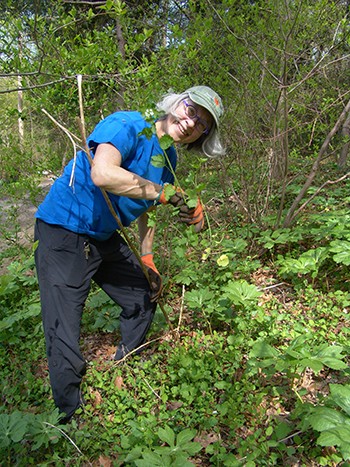
Sandy Whipple, volunteer, continued the effort to control invasives in the Crum Woods, including the now in bloom, garlic mustard (Alliaria petiolata.) photo credit: R. Robert
In addition to this impressive removal, a crew of volunteers continued the effort to control invasives in the Crum Woods, including the now in bloom, garlic mustard (Alliaria petiolata.)
A member of the mustard family (Brassicaceae), this plant is known by several common names, most of which refer to its garlic-like scent and historic use as a cooking herb. “Garlic mustard” is the most widely used common name in North America.
Garlic mustard has a two-year life cycle and appears differently in its first and second years of growth. Its young leaves produce a garlic smell when crushed. As leaves mature, this odor fades. In its first year, garlic mustard produces rosettes of dark-purple to green, kidney-shaped leaves with scalloped edges.
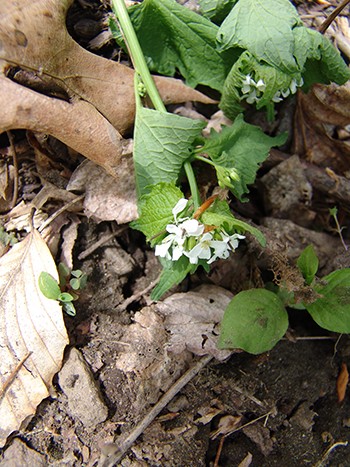
Individual plants can have multiple flowering stalks and the number of flowers and siliques varies greatly from plant to plant and stem to stem. photo credit: R. Robert
Second year plants grow rapidly from the rosette stage to about waist height and produce triangular-shaped leaves with sharply toothed edges. Clusters of small white flowers grow at the top of each stem and slender green fruits, called siliques, radiate outward along the stem below the flowers. Individual plants can have multiple flowering stalks and the number of flowers and siliques varies greatly from plant to plant and stem to stem. The flowers each have four white petals that taper toward the base and six stamens, two long and four short.
Garlic mustard is native to Europe and is found from England east to Czechoslovakia and from Sweden and Germany south to Italy. It has spread from its original range and is now found in North Africa, India, Sri Lanka, New Zealand, Canada and the United States. As of 2000, garlic mustard was present in 34 states and 4 Canadian provinces. Within the U.S., the largest populations are in New England and the Midwest.
Garlic mustard may have been brought to North America for use as a cooking herb; however it is also possible that seeds were accidentally introduced from Europe. The first record of garlic mustard in the United States is from Long Island, NY, in 1868. Since then, humans and animals have spread it across North America. Garlic mustard produces large numbers of seeds that can be transported by humans on boots, clothing, hair, by mowing, in automobiles, and trains. Birds, rodents, and whitetail deer are likely seed dispersers in woodland habitats.
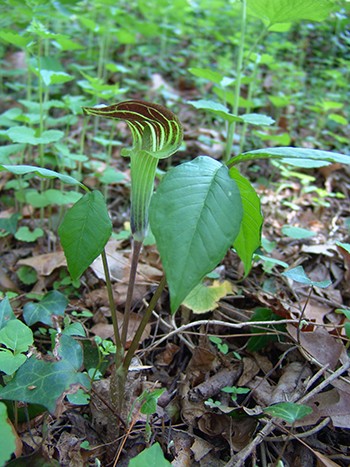
The native jack-in-the-pulpit, Arisaema triphylla, emerging under a garlic mustard “canopy”. photo credit: R. Robert
Garlic mustard is one of the few non-native herbs capable of invading and dominating forest understory communities. Its tolerance of low light levels, coupled with its high seed production and ability to spread rapidly, make garlic mustard a strong competitor. It diverts resources from native spring woodland ephemeral plants such as liverworts, toothworts, solomon-seal, trilliums, trout lilly, sweet-cisley, and many others.
Because it begins growing very early in the spring, garlic mustard has a head start on other flowering plants and tree seedlings. It readily invades forested habitats where it can displace native plants, compete with timber species regeneration, alter soil composition and structure, impact natural associations between plants and fungi, and result in cascading ecosystem impacts. Thus we are working to control its presence in the Crum Woods.
In addition to pulling all that invasive weed, the Mid-Atlantic Invasive Plant Council offers a great recipes for using up all that weed.
Reference source: http://www.ipm.msu.edu/invasive_species/garlic_mustard





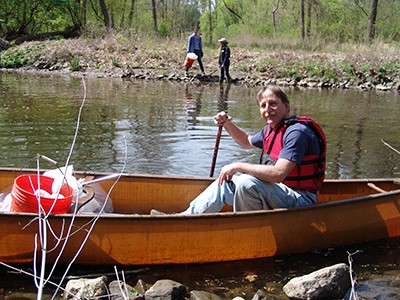
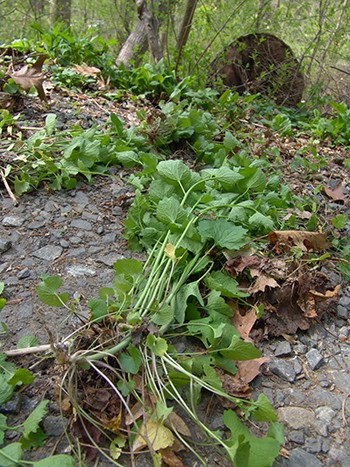
No Comments